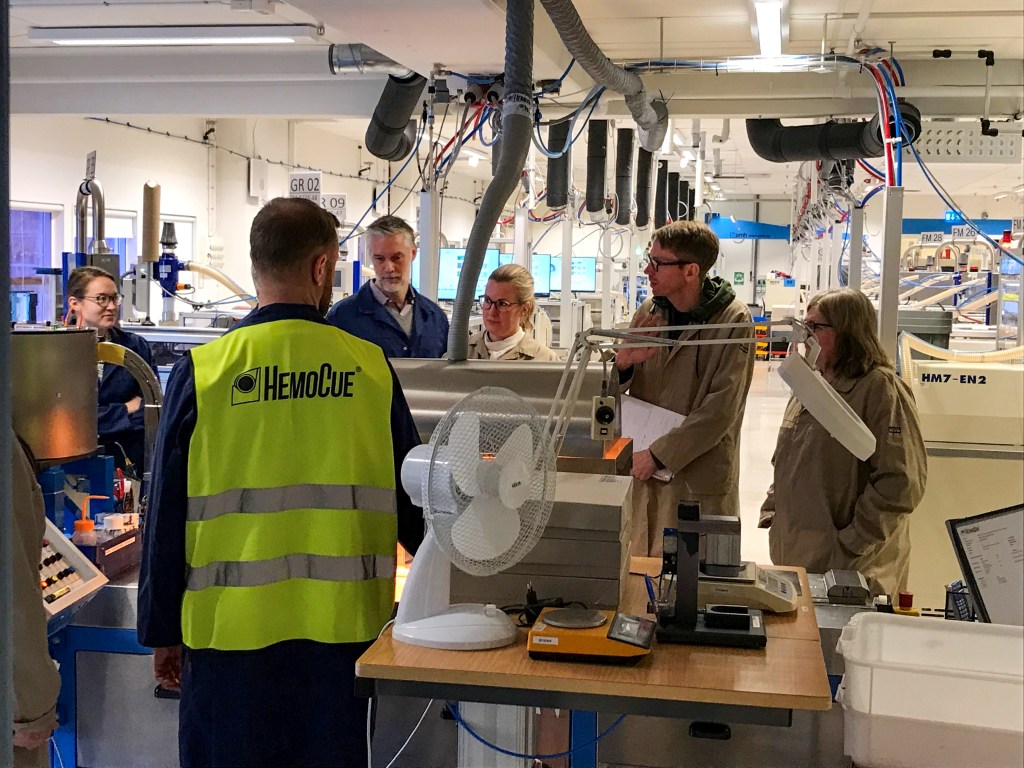Sara Karlsson is a Project Manager in Value Analysis and Value Engineering, building a continuous improvement program from the ground up, helping HemoCue become more aligned and efficient in reaching its goals. Here, she discusses the importance of interdepartmental collaboration and how HemoCue is supporting her as a female leader in a traditionally male-dominated field.

What brought you to HemoCue?
In my last company, I had a role as a project manager within a group of people working with continuous improvement. HemoCue wanted those same discussions about continuous improvement and gave me the opportunity to create my own process in the organization. I liked the challenge of building something from the ground up.
Also, since I have small kids, HemoCue’s passion for employees’ families and private time appealed to me. I can work from home if I want to. I rarely do, because I like to be in the office, but if the kids get sick, then I can work from home and it’s not an issue. They respect your private life. I think that’s a winning concept.
Tell us about your role at HemoCue.
I’ve worked in my position for 2 years now, but it’s changed a lot since I started. I was hired as a continuous improvement engineer and project manager. As time went by, we realized maybe we need more: a focused organization to work with continuous improvement. It’s not a one-person job. Today, I have a core team of seven people who put around 50% of their time into this area.
We take on continuous improvement projects, such as improving the overall equipment efficiency in manufacturing. We calculate different parameters like the amount of stop time and waste to get a score that tells us how efficient our processes are. We also look at where we have excessively high costs and try to reduce the fees, replace what we think is too expensive or improve something where we scrap a lot.
When I started, the different departments were isolated, not communicating enough with each other. One of the reasons for creating my role was that the leadership team wanted more cross-functional work. We’ve needed to create structures and regulatory meetings. So, my biggest impact has been saying, “We need alignment.”






Describe some challenges you face in your role.
Since my team consists of people who only work for me some of the time, it demands a lot of relationship-building, follow-ups, and time management. We have to create a balance between their work within and outside continuous improvement. That’s been the toughest challenge, to not put one role above the other or take away from their work in either role, but I think we’re starting to get there.
For the people who were already involved in continuous improvement last autumn, I don’t have to explain the value of what we’re doing. They buy it. But if I put together a new project team, we’ll need to take it from the beginning. I think it’s a mindset. In my department, it’s crucial that we are aligned with other functions because otherwise we’d have a lot of problems.
As an improvement leader, the downside is that I see all the issues. Even though I like a lot of our processes, I still see where we can do better. To someone else, it may seem as if I’m complaining, but that’s not my purpose. It’s just that I see room for improvement and it’s my job to say something.
Of course, there will always be people who think I’m a young woman coming in only to point out problems in processes that have worked for years. And to an extent that’s true. There were really good processes within R&D, and really good processes within Operations, but they weren’t talking to each other. Now that we’ve completed some projects, the majority of people in the company have seen the results. The reaction has been much more positive now than before. I think we’re earning trust in the process.
How have you been supported in facing those challenges?
I knew it was going to be tough coming into a company to make changes and improvements, so I told HemoCue I needed to be supported.
The company set up coaching sessions for me with the Human Resources Senior Director, who is a woman. Every month, we talk about the challenges of being a woman and a leader. I think women worry, “When are they going to discover I’m not this good?” A man would never think like that. He would just be like, “I’m this good.” If I think, “OK, I don’t know how to tackle this conflict,” or if something makes me feel uncomfortable, I can talk to my coach. She doesn’t tell me what to do; she makes me think in other ways.
HemoCue also sent me to leadership development training last spring—we spent three days out in the woods. They want to help develop more women leaders. My coach has been very excited about it, and we’ve talked a lot about how I can use the different tools I learned. Not only how I can use the tools today, but how I can improve upon them.

What do you see for your future?
First, I really want to develop within leadership and work with people. Of course, because I’m an engineer, I like the numbers, but I like to work with people.
Also, I have a vision that we develop continuous improvement, and that we have more than dotted lines. We’ll have a department working with it, maybe three or four product leads belonging to the group. We need to build an organization of more people actually doing improvements.

Leave a Reply